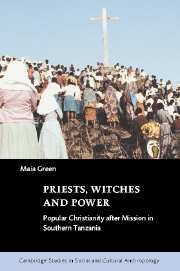Book contents
- Frontmatter
- Contents
- List of maps
- Preface
- 1 Global Christianity and the structure of power
- 2 Colonial conquest and the consolidation of marginality
- 3 Evangelisation in Ulanga
- 4 The persistence of mission
- 5 Popular Christianity
- 6 Kinship and the creation of relationship
- 7 Engendering power
- 8 Women's work
- 9 Witchcraft suppression practices and movements
- 10 Matters of substance
- Notes
- List of references
- Index
- Cambridge Studies in Social and Cultural Anthropology
9 - Witchcraft suppression practices and movements
Published online by Cambridge University Press: 22 September 2009
- Frontmatter
- Contents
- List of maps
- Preface
- 1 Global Christianity and the structure of power
- 2 Colonial conquest and the consolidation of marginality
- 3 Evangelisation in Ulanga
- 4 The persistence of mission
- 5 Popular Christianity
- 6 Kinship and the creation of relationship
- 7 Engendering power
- 8 Women's work
- 9 Witchcraft suppression practices and movements
- 10 Matters of substance
- Notes
- List of references
- Index
- Cambridge Studies in Social and Cultural Anthropology
Summary
This chapter examines the manifestation of public witchcraft suppression practices in Ulanga District, historically and in the present. Movements for the suppression of witchcraft have swept across south eastern and central Africa throughout the twentieth century. Perhaps the best documented is kamcape, observed at different places and points in its history by Audrey Richards, Max Marwick and Roy Willis. The practice of such movements tends to be similar. They are often associated with a single practitioner, either based at a cult centre or on whose authority itinerant specialists work. Their ritual practice is generally public, involving groups of people or even entire villages. It centres on the use of medicine that both suppresses the powers of witches and protects potential victims from witchcraft attack. Often, both witches and accusers participate and receive the same treatment, a key component of which entails the purification of clients. This is achieved by washing parts of the body in special medicines thought to have cleansing, as well as anti-witchcraft properties. The anti-witchcraft medicine of kamcape was explicitly associated with cleansing, the very name of the movement being derived from the verb ‘to clean’ or ‘to scrub’ (Richards 1935: 149; Willis 1968: 8; Marwick 1950: 100). In the Tanzanian movements, this purification sometimes involves shaving off the hair, hence witchcraft suppression practices are talked about in terms of ‘shaving witchcraft’ (Redmayne 1970: 114; Green 1994).
- Type
- Chapter
- Information
- Priests, Witches and PowerPopular Christianity after Mission in Southern Tanzania, pp. 120 - 140Publisher: Cambridge University PressPrint publication year: 2003



